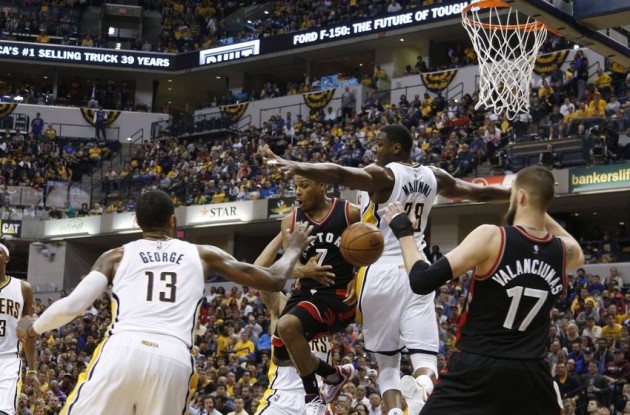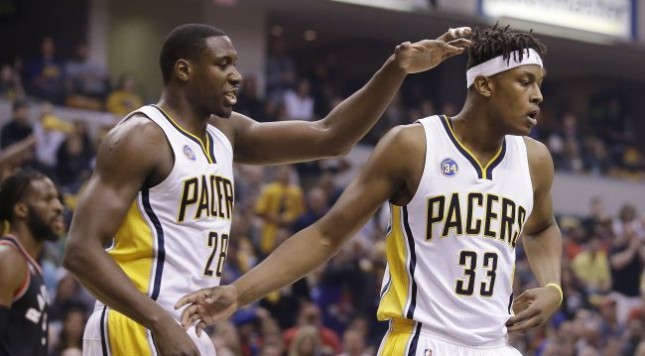We’ve played at least three games in all four Eastern Conference playoff series, making our way through this spread-out first week of the postseason.
Should anything we’ve seen this week truly surprise us? If we are surprised, it says more about us and our expectations than these teams and their players.
Truly, nothing from any of these four series should catch us off guard. If we’ve watched the regular season, the East playoffs have merely extended the 82-game grind into late April.
The two most centrally representative East series are the ones between two separate pairs of teams with the exact same 48-34 records. Both the Atlanta Hawks and Miami Heat took 2-0 leads at home while the Boston Celtics and Charlotte Hornets couldn’t hit enough perimeter shots — partly from stars, partly from role players — to keep pace. It’s true that Atlanta took its lead based on defense, and Miami bolted to its 2-0 advantage because of a remarkably effective offense — to that extent, both series have been very different in terms of style and granular content. However, on a larger level, the patterns are shared.
Start with this link between these two 48-34 series: Team A gains a comfort zone at home while Team B can’t acquire a rhythm on the road. Boston and Charlotte — both young, both overachievers — ran into veterans (Al Horford and Paul Millsap for Atlanta, Dwyane Wade for Miami) who know how to excel in the playoffs and, instructively, set the tone in the locker room for the younger players. What we saw in Games 1 and 2 of each series was very much an education and development process for the Celtics and Hornets.

Jonas Jerebko helped change the tenor of the Boston Celtics’ first-round playoff series against the Atlanta Hawks on Friday night. We’ll see if that shift remains in place in Game 4 and beyond.
In Game 3 of each series, the team trailing 2-0 had to deal with a major absence: Avery Bradley for Boston and Nic Batum for Charlotte. Both Miami and Atlanta could have landed kill shots, but Isaiah Thomas (Boston) and the combo of Jeremy Lin and Marvin Williams (Charlotte) authored profound transformations from Games 1 and 2. The Celtics, with Jonas Jerebko, and the Hornets — with Frank Kaminsky — gained a difference-making performance from a player who was given a more prominent place in the rotation.
Both series have taken noticeable turns, but we’ll see if Game 4 affirms those shifts or marks a point in which the Bradley and Batum injuries become decisive in shaping the final outcome.
These two series — and the four teams contained within them — reveal an East in which identities and progressions don’t last very long. If you learned anything about the East during the regular season, that was the main epiphany about the character of the Eastern Conference.

Kyle Lowry’s series against the Indiana Pacers hasn’t been consistently miserable — that’s been the experience of DeMar DeRozan. Lowry has been a sparkplug for the Raptors at times, but not on Saturday in Game 4.
In the Toronto-Indiana series, the emergence of George Hill turned things around for the Pacers on Saturday in Game 4, but what also caused this series to settle into a 2-2 tie was the drop-off in Kyle Lowry’s performance relative to Game 3. Lowry was a tone-setter for the Raptors on Thursday, and while his shooting percentage has never been that good over the past week against the Pacers, Lowry took more of the initiative in leading his team’s offense. Saturday, that same sense of ownership just didn’t emerge.
To be fair to Lowry, a lower assist total was partly the result of teammates failing to hit shots. That’s a component of the assist — as a statistic — which always has to be kept in mind. Players don’t necessarily become worse passers; they lose assists if teammates don’t finish the play.
Yet, even if you account for that one aspect of Lowry’s Saturday, he didn’t hit a three after making four of them in Game 3. Lowry got into foul trouble in Game 4, a repeat of Game 1. In Games 2 and 3, Lowry was able to be a forceful presence and stay on the floor at the same time. It’s been hard for Lowry to attain the same high level of play from game to game, and with Cory Joseph unexpectedly turning into a pumpkin in Game 4 (no points in 14 minutes), it’s no wonder this series is now a best-of-three.
Toronto and Indiana have had a hard time deciding what kind of team they want to be, just like the four 48-win teams battling for a spot in the East semifinals.
Our final stop is the Cleveland-Detroit series, which might indeed reach its own final stop Sunday night as the Cavaliers go for a sweep.
The Pistons have epitomized the identity of an 8 seed: They’ve been good enough to show why they got into the playoffs, and erratic enough to show why — despite evident talent — they didn’t rise higher.
This isn’t a disappointment for Detroit — everyone knows this is what a young team must go through in order to develop down the line. Moreover, the Pistons are at least getting the benefit of this real-world NBA education while a team in a similar developmental position, the Utah Jazz, didn’t get the same chance against Golden State in the West. The Pistons should benefit from this series in due time.
Nevertheless, the reality of fluctuating performances — especially from Andre Drummond and Reggie Jackson — persists, an affirmation of what you’ve seen in the East this season.
The Cavaliers are the one exception to this rule, but of course, most people with a lick of common sense always knew that the Cavs would likely stand apart from the rest of the crowd. The wise and strong presence of LeBron James in the locker room and on the court gives postseason clarity and peace to the Cleveland roster. That anchored, rooted mindset has been apparent in steady endgame displays in Games 1 and 3.
*
The Eastern Conference — with Cleveland expected to reign as a team set apart — is exactly what you thought it was through one week of playoff competition.
We’ll see if disorder and role reversals continue to emerge in the second week… and how they’ll impact the rest of the East playoffs if they do.

